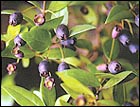Gardener's tips: mid June
This week it’s time to pay attention to your peas, shrubby herbs (which should be trimmed regularly to prevent flowering) and the organic tomatoes need a feed


Peas
Even if your early-sown pea crop has failed because of the unpredictable spring weather, there’s still time to sow peas that will crop in September/October. A first, early, wrinkled variety, such as the reliable Kelvedon Wonder, will take 12 weeks or so to mature after sowing; it’s good for successional sowing and, being compact, it needs less work to support. It’s not too late to think of raising mangetout grow them in pots to speed up germination, plant them out as soon as possible and you’ll get lots of pods, either to eat the whole immediately or as individual peas.
Herbs
Shrubby herbs, such as rosemary and sage and the semi-woody marjoram and thyme should be trimmed regularly to prevent flowering this will make them more useful in the kitchen as they'll produce abundant fresh growth. All herbs, either soft or woody, attract beneficial bees and insects to the garden when in flower, so, if room permits, plant more than one of each variety and rotate the pruning. This way, you will get both the flowers and the fresh shoots, as well as growth suitable for propagation later in the summer.
Organic tomatoes
Start feeding your tomatoes when the first flowers appear. They’ll respond best to liquid feed. Try homemade comfrey liquid; it’s high in potash for flower and fruit development and low in nitrogen it won’t over-stimulate growth; or buy organic tomato feed. Regular watering will help to stop blossom-end rot, which happens if you let the compost dry out and then saturate it. Reduce the watering in dull weather. If you’re growing the cordons up canes, keep tying them loosely to the canes; remove the side shoots as they grow, and be ready to support the trusses of tomatoes if they get too heavy.
June drop
Sign up for the Country Life Newsletter
Exquisite houses, the beauty of Nature, and how to get the most from your life, straight to your inbox.
Apple trees have a natural process of thinning their own fruitlets after a good set. This is known as the June Drop, and happens from the middle of June to the middle of July. On trained and manageable trees, it’s an madvantage to thin the overcrowded fruitlets to get bigger apples later, but don’t do this until after the June Drop (unless there are any malformed fruits).
The thinning of any burgeoning fruit tree seems heartbreaking, but you’ll be rewarded at the end of the season. Pots and containers If you’re constantly watering your pots and containers, you’ll wash away any nutrients the hungry plants have not absorbed. Of course, any contained plant needs water for survival, but to flourish,it will need food, too. We much prefer granular or pelleted ferti-liser to liquid feed. These fertilisers are simple to spread on the surface of the container and will gradually dissolve every time you water the plant. They release nutrients over a longer time, whereas excess liquid feed could run out of the bottom of the pot, meaning that the plant’s nourishment requires more care.
Philip Maddison is head gardener at Harrington Hall, Lincolnshire (www.harringtonhallgardens.co.uk)
Country Life is unlike any other magazine: the only glossy weekly on the newsstand and the only magazine that has been guest-edited by HRH The King not once, but twice. It is a celebration of modern rural life and all its diverse joys and pleasures — that was first published in Queen Victoria's Diamond Jubilee year. Our eclectic mixture of witty and informative content — from the most up-to-date property news and commentary and a coveted glimpse inside some of the UK's best houses and gardens, to gardening, the arts and interior design, written by experts in their field — still cannot be found in print or online, anywhere else.
-
 About time: The fastest and slowest moving housing markets revealed
About time: The fastest and slowest moving housing markets revealedNew research by Zoopla has shown where it's easy to sell and where it will take quite a while to find a buyer.
By Annabel Dixon
-
 Betty is the first dog to scale all of Scotland’s hundreds of mountains and hills
Betty is the first dog to scale all of Scotland’s hundreds of mountains and hillsFewer than 100 people have ever completed Betty's ‘full house’ of Scottish summits — and she was fuelled by more than 800 hard boiled eggs.
By Annunciata Elwes